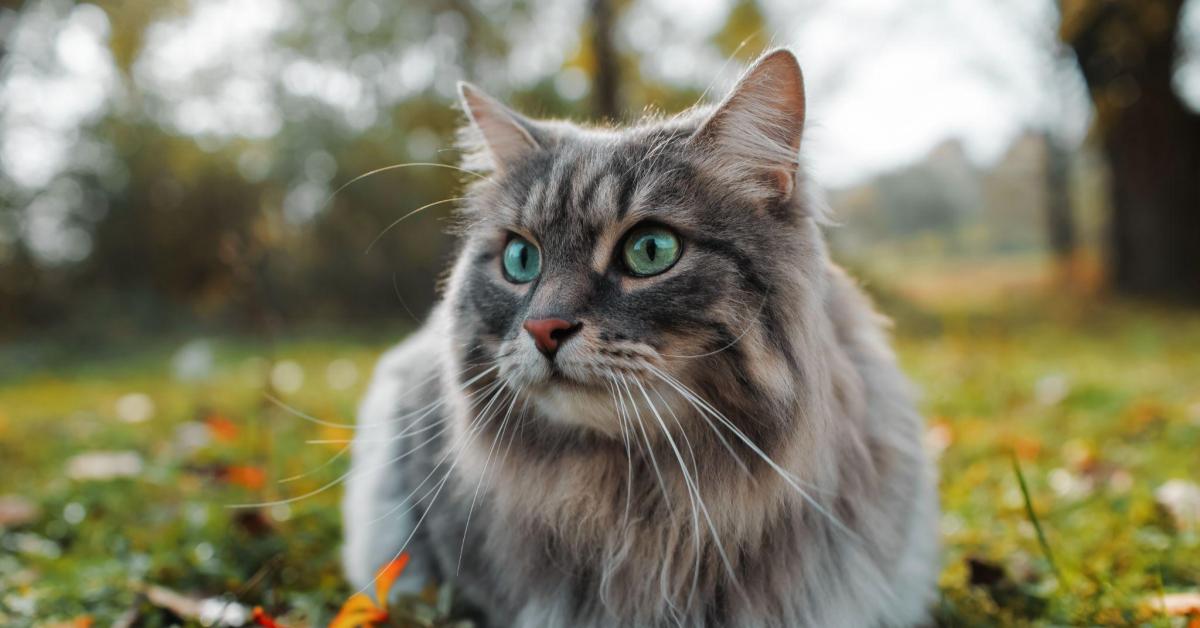Ever wondered, “Why do cats have whiskers?” While they’re certainly a cute feature on a cat’s face, whiskers are so much more. In fact, they’re one of the most vital sensory tools cats have.
Let’s delve into everything you need to know about these tactile hairs.
What is a cat’s whisker made of?
Whiskers, or vibrissae, aren’t just ordinary hairs – they’re intricate sensory structures that give cats heightened awareness of their surroundings. These long, stiff hairs, deeply rooted in specialized hair follicles, are interconnected with nerve endings. Deeply embedded in a cat’s skin, each whisker is surrounded by nerve-rich follicles, forming an intricate network of sensory information.
Why do cats have whiskers?
Cats use their whiskers to detect even the most subtle changes in their environment, from gentle air currents to a slight touch. Your cat’s nervous system is also equipped with proprioceptors aka sensory organs that detect body position and movement. This helps cats navigate the world with unparalleled spatial awareness. Picture your cat effortlessly maneuvering through tight spaces or gracefully leaping onto a perch – this is all thanks to the guidance of their sensitive whiskers.
How does a cat use its whiskers?
Have you ever noticed your cat’s whiskers in motion? It’s more than just a sense of touch and spatial awareness; it’s a sophisticated form of communication. Cats utilize their whiskers to express a range of emotions and intentions. A cat with relaxed whiskers might be in a content, calm state, while forward-facing whiskers indicate excitement or curiosity.
Understanding this unique form of body language adds a new dimension to our connection with feline friends. Observing whiskers can offer insights into your cat’s mood, allowing for deeper understanding and bonding.
Do different cat breeds have different whiskers?
Whiskers, like cats themselves, come in various shapes and sizes. Did you know that different cat breeds exhibit diverse whisker characteristics? Take the majestic Maine Coon, for example, known for its larger size and boasting longer whiskers compared to other breeds. In contrast, some breeds may have shorter, more delicate whiskers.
Appreciating the diversity in whisker length and structure among cat breeds enriches our understanding of these remarkable creatures. Each whisker, regardless of its length, plays a vital role in a cat’s sensory perception and interaction with the world.
What happens if you cut off a cat’s whiskers?
Cutting off a cat’s whiskers is inhumane and should never be done. As we know, whiskers are an integral part of a cat’s anatomy; they’re in charge of vital functions such as sensory perception, communication, and overall well-being.
Here’s what happens if you cut off a cat’s whiskers:
Impaired sensory perception
Whiskers are highly sensitive and help cats navigate their surroundings. They are deeply embedded in the cat’s body and are connected to the nervous system, providing essential information about the cat’s environment. Cutting off whiskers can impair a cat’s ability to sense objects and navigate in low-light conditions.
Loss of spatial awareness
Whiskers are crucial for a cat’s spatial awareness. They help cats gauge the width of openings and determine if they can fit through small spaces. Without whiskers, cats may become disoriented and have difficulty judging distances, which can lead to accidents or injuries.
Disrupted communication
Cats use their whiskers for communication. When a cat is agitated or frightened, the whiskers may be pulled back against the face. Cutting off the whiskers removes this important signaling mechanism, making it harder for the cat to express its emotions and communicate with other cats.
Discomfort and stress
Cutting off a cat’s whiskers is painful and stressful for the animal. Whiskers are rich in nerve endings, and their removal can cause pain and discomfort. Additionally, the cat may experience stress and anxiety due to the loss of an important sensory tool.
Do cat whiskers grow back?
Yes, cat whiskers do grow back. If a cat’s whiskers are trimmed or accidentally cut, they will regrow over time.
The rate of whisker growth can vary among individual cats, but in general, whiskers grow back at a similar pace to other types of hair. It might take several weeks to a few months for a cat’s whiskers to fully regrow.
If you have concerns about your cat’s whiskers or if they have been accidentally trimmed, it’s advisable to let them grow back naturally. If you notice any unusual behavior or signs of distress in your cat, consult with your veterinarian.
What is whisker fatigue?
Whisker fatigue, also known as “whisker stress” or “whisker exhaustion,” is a concept that suggests a cat may experience discomfort or stress when its sensitive whiskers are overstimulated. Some signs that a cat may be experiencing whisker fatigue include reluctance to eat from a deep bowl, pawing at the food, or displaying signs of stress during mealtimes.
When arranging food and water bowls, avoid placing them in tight spaces that could induce whisker fatigue. Cats may experience discomfort if their sensitive vibrissae repeatedly touch the edges of bowls.
Note: While whisker fatigue is a consideration, it is not universally accepted among veterinarians and experts in feline behavior. Some argue that whisker fatigue may be more of a speculative concept than a proven phenomenon. Nevertheless, respecting your cat’s sensitive hairs is important.
Caring for your cat’s whiskers
As you can see, cat’s whiskers are not merely facial features, but an indispensable sensory tool crucial for their survival. Nurture your cat’s sensory world by kitty-proofing your home, respecting their space, and handling them with care.




